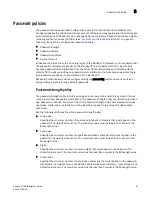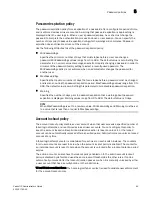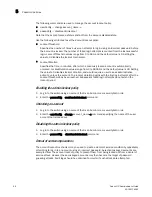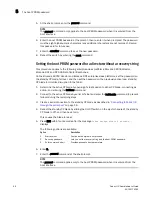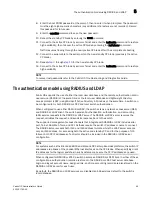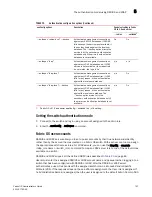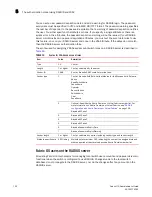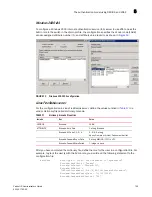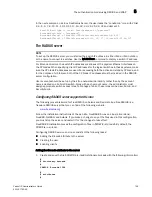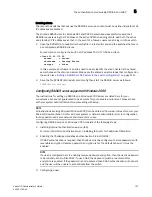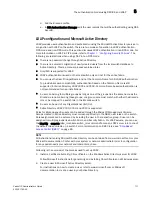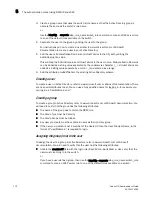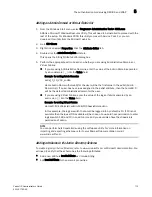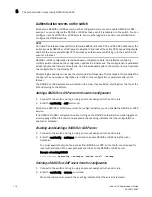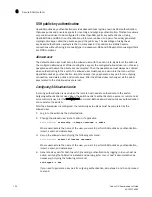
Fabric OS Administrator’s Guide
105
53-1001763-02
The authentication model using RADIUS and LDAP
5
In the next example, on a Linux FreeRadius Server, the user takes the “zoneAdmin” role, with VFlist
2, 4, 5, 6, 7, 8, 10, 11, 12, 13, 15 17, 19, 22, 23, 24, 25, 29, 31 and HomeLF 1.
user300 Auth-Type := Local, User-Password == "password"
Brocade-Auth-Role = "zoneadmin",
Brocade-AVPairs1 = "HomeLF=1;LFRoleList=securityadmin:2,4-8,10”
Brocade-AVPairs2 = "LFRoleList=admin:11-13, 15, 17, 19;user:22-25,29,31"
The RADIUS server
NOTE
To set up the RADIUS server, you must know the switch IP address, in either IPv4 or IPv6 notation,
or the name to connect to switches. Use the ipAddrShow command to display a switch IP address.
For Brocade directors, the switch IP addresses are aliases of the physical Ethernet interfaces on
the CP blades. When specifying client IP addresses for the logical switches in these systems, make
sure the CP blade IP addresses are used. For accessing both the active and standby CP blade, and
for the purpose of HA failover, both of the CP blade IP addresses must be included in the RADIUS
server configuration.
User accounts should be set up by their true network-wide identity, rather than by the account
names created on a Fabric OS switch. Along with each account name, the administrator must
assign appropriate switch access roles. To manage a fabric, these roles can be User, Admin, and
SecurityAdmin.
Configuring RADIUS server support with Linux
The following procedures work for FreeRADIUS on Solaris and Red Hat Linux. FreeRADIUS is a
freeware RADIUS server that you can find at the following web site:
www.freeradius.org
Follow the installation instructions at the web site. FreeRADIUS runs on Linux (all versions),
FreeBSD, NetBSD, and Solaris. If you make a change to any of the files used in this configuration,
you must stop the server and restart it for the changes to take effect.
FreeRADIUS installation places the configuration files in
$PREFIX/etc/raddb
. By default, the
PREFIX is
/usr/local
.
Configuring RADIUS service on Linux consists of the following tasks:
•
Adding the Brocade attribute to the server
•
Creating the user
•
Enabling clients
Adding the Brocade attribute to the server
1. Create and save the file
$PREFIX/etc/raddb/dictionary.brocade
with the following information:
#
# dictionary.brocade
#
VENDOR Brocade 1588
#
# attributes
#
Summary of Contents for 53-1001763-02
Page 1: ...53 1001763 02 13 September 2010 Fabric OS Administrator s Guide Supporting Fabric OS v6 4 0 ...
Page 4: ...iv Fabric OS Administrator s Guide 53 1001763 02 ...
Page 24: ...xxiv Fabric OS Administrator s Guide 53 1001763 02 ...
Page 28: ...xxviii Fabric OS Administrator s Guide 53 1001763 02 ...
Page 32: ...xxxii Fabric OS Administrator s Guide 53 1001763 02 ...
Page 40: ...xl Fabric OS Administrator s Guide 53 1001763 02 ...
Page 42: ...2 Fabric OS Administrator s Guide 53 1001763 02 ...
Page 54: ...14 Fabric OS Administrator s Guide 53 1001763 02 High availability of daemon processes 1 ...
Page 74: ...34 Fabric OS Administrator s Guide 53 1001763 02 Basic connections 2 ...
Page 102: ...62 Fabric OS Administrator s Guide 53 1001763 02 Audit log configuration 3 ...
Page 214: ...174 Fabric OS Administrator s Guide 53 1001763 02 Management interface security 7 ...
Page 228: ...188 Fabric OS Administrator s Guide 53 1001763 02 Brocade configuration form 8 ...
Page 276: ...236 Fabric OS Administrator s Guide 53 1001763 02 Creating a logical fabric using XISLs 10 ...
Page 404: ...364 Fabric OS Administrator s Guide 53 1001763 02 ...
Page 440: ...400 Fabric OS Administrator s Guide 53 1001763 02 Performance data collection 17 ...
Page 480: ...440 Fabric OS Administrator s Guide 53 1001763 02 F_Port masterless trunking 19 ...
Page 494: ...454 Fabric OS Administrator s Guide 53 1001763 02 Buffer credit recovery 20 ...
Page 574: ...534 Fabric OS Administrator s Guide 53 1001763 02 Hexadecimal overview E ...

